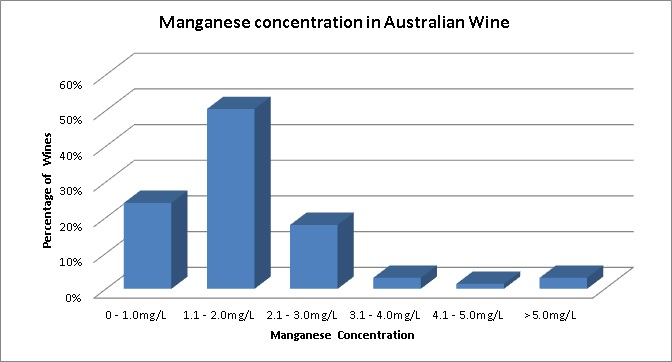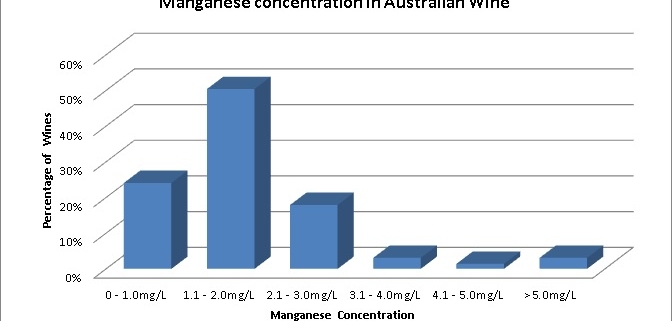Do you know what levels of trace metals are in your wine?
Introduction
Wine contains a number of metal ions in very small, that is, trace amounts. These trace metals are generally harmless and in fact can be essential micro nutrients for humans. Most countries have legal limits on the level of certain trace metals in wine. The recent change in limits on manganese in China is just one example of the need for winemakers to be aware of the levels of several key trace metals in their wines.
Essential Trace metals needed for good nutrition
Metal ions are found in both plant and animal cells in various forms and many are needed for sound human nutrition. The concentration of trace metals varies in different food sources; with some food sources prized for the quantities they can provide e.g. iron and zinc in red meat, calcium in dairy products(1).
The table below shows major elements and essential trace elements (sometimes also referred to as trace minerals) needed for human nutrition:
| Major Elements | Essential Trace Elements | ||
| Name | Symbol | Name | Symbol |
| Sodium | Na | Manganese | Mn |
| Magnesium | Mg | Iron | Fe |
| Phosphorus | P | Cobalt | Co |
| Sulfur | S | Nickel | Ni |
| Chlorine | Cl | Copper | Cu |
| Potassium | K | Zinc | Zn |
| Calcium | Ca | Selenium | Se |
| Molybdenum | Mo | ||
| Iodine | I | ||
Although we need these minerals, some can become harmful if their concentration is too high. Sodium is an example of an element that in modern societies is often found in processed foods above levels deemed safe. Prior to industrialisation, concentrations were very low (2).
A number of the major and trace elements are also found in wine although it appears that they are not often considered when looking at health benefits of wine.
Manganese in wine
One trace metal that has been of intense interest to some Australian winemakers is manganese. This is because the Chinese authorities have begun to reject wine containing more than 2 ppm (mg/L) of manganese. This was discussed by the author in the Grapegrower and Winemaker May 2014 issue. Why the Chinese authorities have decided to set such a low limit and whether this level is based upon any legitimate health risk is unknown. We do know however, that many wines destined for China have been tested in our laboratories since this change in Chinese conditions was announced by Wine Australia.
A summary of our manganese results to date as shown in Figure 2 indicates that 26% of these wines would not pass the 2 ppm limit placed by China. Interestingly the highest result that we have found is 10 ppm.
Figure 2:

Whether the currently imposed limit of 2 ppm for manganese in wine destined for China is maintained will be up to the relevant authorities to discuss and consider. However, at this stage any Australian winery exporting to China would be wise to check the manganese levels in their wines.
Other trace metals in wine
The main trace metals we have tested in wine over many years are copper and iron. This is because of the prevalence of these trace metals in the winemaking process, the potential for creating copper or iron casse, and as they are limited by the regulations in certain countries.
Copper in wine can arise from vineyard sprays, the addition of copper salts to remove sulfides that form during fermentation, and from winery equipment that contains copper (3) – although this last factor is less of an issue these days, at least in New World wine producing countries.
The concentration of copper that is allowed in a number of countries is shown in Figure 3 (4). It can be seen that this varies widely: the lowest is 0.5 ppm and highest 10 ppm!
Again it is an important consideration for producers as our testing has shown that over 12% of wines were over the 0.5 ppm limit set by the USA (4) . As this is a major export destination for Australian wines it is another important testing parameter to consider.
| REGION | MAXIMUM ALLOWABLE | UNIT |
| CONCENTRATION | ||
| Argentina | 1.0 | mg/L |
| Canada | 1.0 | mg/L |
| China | 1.0 | mg/L |
| European Union | 1.0 | mg/L |
| Germany | 2.0 | mg/L |
| India | 5.0 | mg/L |
| Russia | 5.0 | mg/L |
| Singapore | 7.0 | mg/L |
| South AFrica | 1.0 | mg/L |
| Switzerland | 1.0 | mg/kg |
| Turkey | 1.0 | mg/kg |
| Vietnam | 10.0 | mg/kg |
| United States of America | 0.5 | mg/L |
Iron can exist in trace amounts in wine and arises mainly from the vineyard; however contamination can occur from steel equipment that is used in the wine production process. Although this is less of an issue nowadays with most winery equipment being made of stainless steel. However, any non stainless steel that comes into contact with grapes or wine (e.g. bins or hoppers) can contribute to the total iron content(5) .
Other metals we have tested for over the years are the major elements potassium, sodium, calcium, magnesium, and the trace elements lead, tin, cadmium and arsenic (arsenic is not strictly a metal – it is a metalloid; i.e. it exhibits properties of both metals and non-metals).
Limits on trace metals in wine
As stated above the allowable limit on a number of trace metals varies by country. This has been shown for copper, however the concentration limit for other trace metals also varies widely and it is important for wine producers to be aware of these limits and the concentration of the major ones in their wines.
Measuring trace metals – ICP versus AAS
We use the instrumental technique known commonly as ICP. This is an abbreviation of Inductively Coupled Plasma Optical Emission Spectroscopy.
ICP is a very versatile technique as it allows a number of trace metals to be tested at the same time in the same sample. Unlike the other popular trace metal technique AAS (Atomic Absorption Spectroscopy) it does not require a separate lamp for each element and so it is therefore very quick to set up for a wide range of elements that have not been tested previously.
Conclusion
Wine has been known to contain several trace metals in low levels for as long as it has been possible to measure them. At low levels these trace metals are not harmful, in fact some can be essential for good human nutrition. The limits imposed on several trace metals by different countries do vary, as we have seen recently with manganese in China. It is important that winemakers are aware of the key analytes such as copper and iron in their wines; as well as manganese if they are considering exporting to China.
References
1. Ulijaszek, S; Mann, N; Elton, S; Evolving Human Nutrition; Cambridge Press, 2013, pp 161-162
2. Ibid, pp 174-176
3. Zoecklein, B.W; Fugelsang, K.C; Gump, B.H; Nury, F.S; Wine Analysis and Production, Aspen Publishers Inc., New York, 1995, pp 200-201
4. Byrne, S; Petiole and wine Analysis, Paper presented at the 15th AWITC, 2013 Sydney.
5. Rankine, B; Making Good Wine, Pan Macmillan, 1989, pp 244-245
Copyright© 2014 Vintessential Laboratories. No part of this publication may be reproduced in any form or by any means without the permission in writing from the copyright owner.


